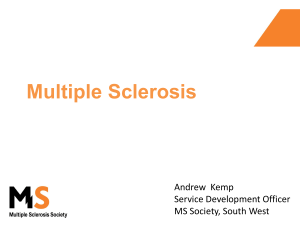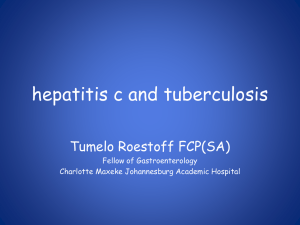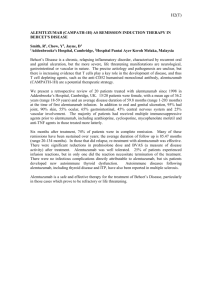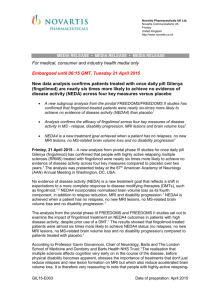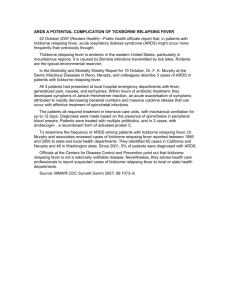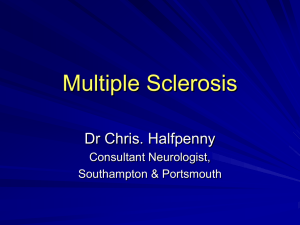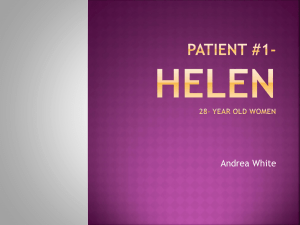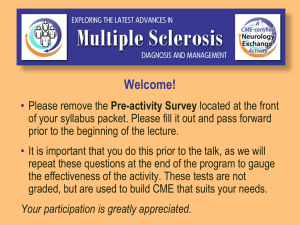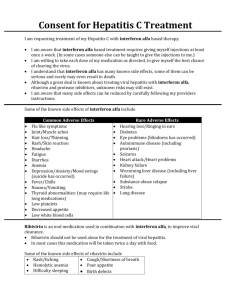Choices Disease Modifying Treatments - MS-UK
advertisement
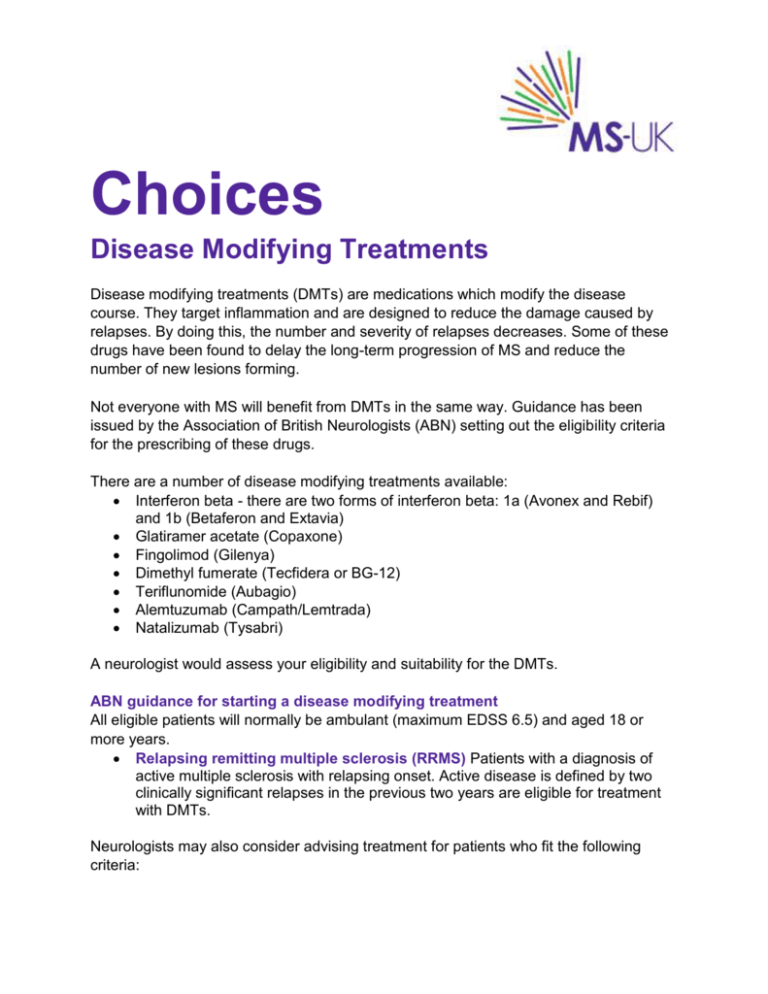
Choices Disease Modifying Treatments Disease modifying treatments (DMTs) are medications which modify the disease course. They target inflammation and are designed to reduce the damage caused by relapses. By doing this, the number and severity of relapses decreases. Some of these drugs have been found to delay the long-term progression of MS and reduce the number of new lesions forming. Not everyone with MS will benefit from DMTs in the same way. Guidance has been issued by the Association of British Neurologists (ABN) setting out the eligibility criteria for the prescribing of these drugs. There are a number of disease modifying treatments available: Interferon beta - there are two forms of interferon beta: 1a (Avonex and Rebif) and 1b (Betaferon and Extavia) Glatiramer acetate (Copaxone) Fingolimod (Gilenya) Dimethyl fumerate (Tecfidera or BG-12) Teriflunomide (Aubagio) Alemtuzumab (Campath/Lemtrada) Natalizumab (Tysabri) A neurologist would assess your eligibility and suitability for the DMTs. ABN guidance for starting a disease modifying treatment All eligible patients will normally be ambulant (maximum EDSS 6.5) and aged 18 or more years. Relapsing remitting multiple sclerosis (RRMS) Patients with a diagnosis of active multiple sclerosis with relapsing onset. Active disease is defined by two clinically significant relapses in the previous two years are eligible for treatment with DMTs. Neurologists may also consider advising treatment for patients who fit the following criteria: 1) patients within 12 months of a clinically significant clinically isolated syndrome when MRI evidence predicts a high likelihood of recurrent episodes (i.e. development of multiple sclerosis) 2) patients with only a single major relapse in the preceding two years, but combined with MRI evidence of continuing disease activity (i.e. meet the revised McDonald criteria for MS) 3) patients aged less than 18 with relapsing remitting multiple sclerosis. There are several drugs licensed for people with RRMS, these are: interferon beta (Avonex, Betaferon, Extavia and Rebif), glatiramer acetate (Copaxone), fingolimod (Gilenya), dimethyl fumerate (Tecfidera or BG-12) and teriflunomide (Aubagio). Rapidly evolving severe relapsing remitting multiple sclerosis (RES RRMS) Patients with RES RRMS should be considered for treatment with natalizumab (Tysabri) by a neurologist. Rapidly evolving or severe multiple sclerosis is defined by two or more disabling relapses in one year, with one or more gadolinium-enhancing lesions on brain magnetic resonance imaging (MRI) or a significant increase in T2 lesion load compared with a previous MRI. For more information, please see our Choices leaflet ‘Tysabri’. Secondary progressive multiple sclerosis (SPMS) Treatment is not recommended in non-relapsing secondary progressive multiple sclerosis and only in relapsing secondary progressive multiple sclerosis when relapses are the predominant cause of increasing disability. Interferon beta (Avonex, Betaferon, Extavia and Rebif) is licensed for some people with secondary progressive MS, who demonstrate relapses. Glatiramer acetate is not available for those with secondary progressive MS (it has not been tested in this type of MS). Primary progressive multiple sclerosis (PPMS) No disease modifying treatment is indicated. Clinically Isolated Syndrome (CIS) Clinically Isolated Syndrome is used to describe a first neurologic episode that lasts at least 24 hours, and is caused by inflammation/demyelination in one or more sites in the central nervous system. This is sometimes diagnosed before a formal diagnosis of MS can be made. Those with CIS who show abnormalities on MRI scans within one year, may be offered treatment with a DMT. Some disease modifying treatments are licensed for use in CIS. These are: interferon beta 1a (Avonex), interferon beta 1b (Betaferon and Extavia), and glatiramer acetate (Copaxone). Source: www.theabn.org No treatments are licensed for use during pregnancy. What is a relapse? The National Institution for Care Excellence (NICE) published guidelines in October 2014 for the management of multiple sclerosis. In these guidelines a relapse can be diagnosed by a GP or neurologist if: “The person with MS has developed new symptoms or has a worsening of existing symptoms, and these symptoms have lasted for more than 24 hours in the absence of infection or any other cause after a stable period of a least one month.” What are the disease modifying treatments? Interferon Beta-1a Interferons are proteins, produced naturally by the body that help us to fight infection. There are currently two interferon beta-1a DMTs available – Avonex (manufactured by Biogen) and Rebif (manufactured by Serono). Avonex blocks the action of one type of protein called gamma interferon. It reduces the autoimmune reaction that causes inflammation and destruction of myelin. It has been shown to reduce the rate of relapse by about one-third in people with relapsing remitting MS. It also reduces the severity of relapses that occur. It must be injected into the muscle once a week and should be stored in the fridge. Rebif is like Avonex in that it also works to block the action of the gamma interferon protein. However, Rebif has to be injected subcutaneously (under the skin, into body fat) three times per week and should also be stored in the fridge. Rebif is available in two different dosages. Rebif has been shown to reduce the rate of relapse by about one-third in people with relapsing remitting MS. It also reduces the severity of relapses that occur. Avonex and Rebif are licensed for relapsing remitting multiple sclerosis and some people with secondary progressive MS. Avonex and Rebif are also licensed for clinically isolated syndrome, within 12 months of the first episode if MRI evidence predicts a high likelihood of recurrent episodes. The most common adverse effects experienced with Avonex and Rebif both of these treatments is flu-like symptoms after injecting and the injection site may have redness or swelling, or sometimes itching. They can also cause changes in menstruation, blood abnormalities and mood swings; however, these symptoms are less common. Most people find that these adverse effects disappear after 3 months. If the adverse effects persist, a conversation with the MS nurse or neurologist would be recommended. Interferon Beta-1b There are currently two Interferon beta-1b DMTs available – Betaferon (manufactured by Schering) and Extavia (manufactured by Novaratis). Both Betaferon and Extavia are thought to block the action of one type of immune cell, called a T-cell and reduce the autoimmune reaction that causes inflammation and destruction of myelin. They have been shown to reduce the rate of relapse by about one-third in people with relapsing remitting MS and also reduce the severity of relapses that occur. Betaferon and Extavia must be injected subcutaneously (under the skin, into body fat) every other day. They do not need to be stored in the fridge, but must be mixed before use. The most common adverse effects experienced with Betaferon and Extavia are flu-like symptoms after injecting and injection site reactions. They can also cause changes in menstruation, blood abnormalities and mood swings; however, again these symptoms are less common. Betaferon and Extavia are licensed for relapsing remitting multiple sclerosis and some people with secondary progressive MS. Betaferon and Extavia are also licensed for clinically isolated syndrome, within 12 months of the first episode if MRI evidence predicts a high likelihood of recurrent episodes. Glatiramer acetate (Copaxone) Glatiramer acetate works differently from the interferons in that it is a synthetic combination of four amino acids which resemble the myelin protein. It is thought to work by preventing the production of immune cells that attack myelin. The rate of relapse in people taking glatiramer acetate is generally reduced by onethird. Glatiramer acetate needs to be injected subcutaneously every day. Common adverse effects are injection-site reactions and lipotrophy (indentations under the skin). Glatiramer acetate can also cause chest tightness, breathlessness, anxiety, flushing and palpitations after injection. However, these symptoms are less common and they typically pass within a few minutes. Glatiramer acetate is licensed for relapsing remitting multiple sclerosis and some people with clinically isolated syndrome, within 12 months of the first episode if MRI evidence predicts a high likelihood of recurrent episodes. Fingolimod (Gilenya) Fingolimod (manufactured by Novaratis) is an immuno-modulating drug, which attaches to the surface of certain white blood cells and reduces their ability to getting into the central nervous system. This is thought to reduce the nerve damage associated with MS. Fingolimod was shown to reduce the risk of relapses by 67% compared to a placebo in trials. Fingolimod is taken as a tablet, once a day. Possible adverse effects include changes to liver function, macular edema (an accumulation of fluid in the macular area of the eye -- the central area of vision – that sometimes causes blurred vision), headache, respiratory tract infection, shortness of breath, diarrhea and nausea. Fingolimod can cause a decrease in heart rate so the first dose will be monitored in hospital for six hours Fingolimod is licensed for adults with highly active relapsing-remitting MS. Such people have a high disease activity as characterised as one relapse in the previous year despite being on another disease modifying therapy, such as interferon for at least 12 months. In June 2014, NHS England published new guidelines to allow a switch to fingolimod for those patients with highly active RRMS, if they met the following criteria: Patients whose relapse rate is unchanged, or has increased compared to the previous year, while on any of the beta interferons or glatiramer acetate (Copaxone). Patients who are receiving natalizumab (Tysabri) and are at a high risk of developing PML. See our Choices leaflet, ‘Tysabri’ for more information. Additionally in October 2014 the Scottish Medicines Consortium (SMC) licensed fingolimod as a first-line treatment for people with rapidly evolving severe relapsing remitting MS (RES RRMS). This means fingolimod can be offered to people with RES RRMS without them having to have taken any previous medication. In December 2014 Novartis issued an updated from phase 3 trials into fingolimod and its potential use in people with primary progressive MS. Unfortunately these trials did not did not show a significant difference between fingolimod and placebo on a combination of disability measures. Dimethyl fumerate (BG 12 or Tecfidera) Dimethyl fumerate may have an anti-inflammatory effect on the immune system. Studies have shown that dimethyl fumerate reduces the annual MS relapse rate by around one-half. Some studies also showed a significant reduction in the progression of the disease, while other studies did not demonstrate this. Dimethyl fumerate is taken as a tablet, twice a day. Common adverse effects reported are flushing and feeling hot, gastrointestinal upset and headaches. Dimethyl fumerate is licensed for relapsing remitting MS. The FDA approved dimethyl fumerate in March 2013 to treat adults with relapsing-remitting forms of MS. In February 2014 dimethyl fumerate was approved by the EMA (European Medicines Agency). It received full NICE appraisal in July 2014, and is available in the UK. Teriflunomide (Aubagio) Teriflunomide inhibits the function of specific immune cells that have been implicated in MS. It can inhibit a key enzyme required by white blood cells (lymphocytes) – which in turn reduces the T and B immune cells that are active in MS, from multiplying. As well as this, it has shown to have other anti-inflammatory and immunomodulating actions. Studies showed that teriflunomide reduced relapses by one-third, and also slowed down progression of the condition. Teriflunomide is taken as a tablet, once a day. Common adverse effects are gastrointestinal upset, hair thinning and changes in liver function. Teriflunomide should not be taken by women considering pregnancy because of potential risks to the unborn baby. A woman of child-bearing age considering teriflunomide must take a pregnancy test and ensure adequate contraception is in place before starting the drug. Teriflunomide stays in the body for a long time and if a woman taking teriflunomide suspects pregnancy, she must immediately contact her GP and, if a pregnancy is confirmed, teriflunomide can be ‘flushed out’ of the body by taking activated charcoal or cholestyramine over several days. Teriflunomide received NICE approval as an NHS treatment in January 2014 and can be prescribed for adults with active relapsing remitting MS (normally defined as two clinically significant relapses in the past two years), providing they do not have rapidly evolving severe relapsing remitting multiple sclerosis (RES RRMS). Alemtuzumab (Campath/Lemtrada) Alemtuzumab was originally licensed for the treatment of leukemia. It is an anti-CD52 monoclonal antibody which kills T-cells, a type of lymphocyte involved in the MS immune response. Once the T-cells are killed, the immune system repopulates, leading to a modified immune response that no longer regards myelin and nerves as foreign, and therefore stops attacking them. Alemtuzumab is delivered by two infusions, twelve months apart. The first infusion is delivered over five days, and the second over three days. Infusions take place in a hospital or infusion clinic. Two two-year trials looked at the effect of alemtuzumab: one trial enrolled people recently diagnosed with relapsing remitting MS, who had not taken any other disease modifying drugs, and another trial looked at people with relapsing remitting MS, who still had relapses despite being on an interferon. In the first trial of people recently diagnosed with RRMS, alemtuzumab reduced relapses by 55 percent compared to people taking interferon beta 1a. In the group of people taking alemtuzumab, 78 percent did not experience a relapse during the two years of the trial. The people in the alemtuzumab group also demonstrated that the drug had a greater effect on reducing the progression of MS, compared to the interferon group. In the second trial of people who had been on interferons previously, alemtuzumab reduced relapses by 49 percent compared to interferon beta-1a (Rebif). In one of the trials, 65 percent of people taking alemtuzumab did not have relapse in the two years of the trial, compared to 49 percent of people taking interferon. Alemtuzumab was also shown to have a positive effect on MS progression, with 8 percent of people taking alemtuzumab reporting a worsening of their EDSS scale, compared to 11 percent of people on interferon during the two-year trial. Adverse effects reported for alemtuzumab include one-third of people reporting changes to their thyroid function, which while treatable, can mean lifelong medication was necessary. One percent of people reported a blood clotting disorder called Immune Thrombocytopenic Purpura (ITP). While serious, ITP can be treated effectively. Other adverse effects reported related to kidney function, reactions at the infusion site and respiratory infections. More common adverse effects reported were flu-like symptoms after the infusion was given. The drug received NICE appraisal as an NHS treatment in May 2014 from NICE and in July 2014 from the Scottish Medicines Consortium (SMC). Alemtuzumab is licensed for people with active relapsing remitting MS. Natalizumab (Tysabri) A monoclonal antibody called natalizumab is also available as a treatment for MS. It works by preventing immune cells leaving the blood stream and entering areas of inflammation. Natalizumab has to be given by intravenous infusion every 4 weeks at either an infusion centre or a hospital. Natalizumab can cause a potentially fatal brain infection – Progressive Multifocal Leukoencephalopahy (PML), so close monitoring is done to assess the risk of the person undergoing infusions. For more information, please see our Choices leaflet ‘Tysabri’. Choosing a disease modifying drug Once diagnosed with MS, your neurologist will talk to you about any medication you may require and be eligible for. They will discuss with you all your possible options. One thing to consider when looking at these medications is your lifestyle and how the administration of these drugs will fit into your day-to-day living. There are a number of factors you may want to consider, and discuss with your family and neurologist. For example, what are the benefits of a DMT in the short-, mid- and long-term? What are some of the common adverse effects? How is the therapy administered – tablet, injection or infusion? Is this right for my lifestyle? Openly discuss all the options with your MS nurse and/or neurologist to come to a decision as to what is the best course of treatment for you. Coping with adverse effects The adverse effects of these drugs are different per therapy. It is important to talk to your MS Nurse or neurologist about what adverse effects the drug may cause. Adverse effects are generally not severe and there are various ways to manage them. If you suffer from flu-like symptoms after injecting, try changing the time of day you take your injection; possibly to just before bedtime so you can sleep through the side-effects. Alternatively, it is recommended that you take paracetamol or ibuprofen two hours before the injection to ease the symptoms. If you suffer from injection-site reactions, you could try using Emla cream which numbs the area prior to the injection. Always rotate the injection site – avoid injecting the same area each time. It may also help to ensure the drug is at room temperature and also warming the skin before injecting may also help make your injection more comfortable. If you are on any of the oral therapies, ask your MS nurse how to manage any adverse effects you are experiencing. If the adverse effects become severe or you feel unable to cope with them, contact your MS nurse or neurologist who will be able to advise you further. Contact our helpline on 0800 783 0518 to find your nearest MS nurse. Drugs in development All drugs need to be licensed and go through regulatory procedures before they are made available. Many drugs are currently being developed to treat multiple sclerosis. The list below contains drugs that are either currently in trials or have completed their trials, but are not yet licensed. Some have been put forward for European licensing. AXT-MS-1467 ATX-MS-1467 is a peptide-based drug consisting of four amino acids obtained from myelin basic protein (MBP). It is believed to protect myelin by reducing the immune system’s harmful response to the nerve’s coating. It does this through the inhibition of the T-cell’s response to myelin basic protein (MBP). A T-cell is type of white blood cell or lymphocyte. The drug is currently in early stages of testing for RRMS and SPMS. Phase 1 was completed in the US in July 2013 and patient recruitment is underway for Phase 2. Daclizumab Daclizumab is a monoclonal antibody that blocks the activity of the chemical messenger interleukin 2, in the immune system. It also helps prevent the growth of lymphocytes. Daclizumab is currently in phase 3 trials for relapsing remitting MS. The study is called DECIDE which is comparing the drug with interferon beta 1a (Avonex) in patients with RRMS. The results of the trial were announced in June 2014. Daclizumab showed a 45 percent reduction in relapse rate compared to Avonex. Another study called SELECT is a phase 3 trial looked at the effectiveness of different doses of Daclizumab. Daclizumab reduced the annualised relapse rate by 54 percent when given as 150mg, and 50 percent when given as 300mg injections, compared to a placebo. In these trials the common adverse effects were infections, serious skin infections and changes in liver function. Laquinimod Laquinimod affects the level of certain cytokines (substances released by immune cells) and reduces the passage of immune cells into the brain and spinal cord. Studies have also suggested that this drug may have a protective effect on the nervous system and anti-inflammatory actions. In January 2014 the manufacturers Teva and Active Biotech submitted an application to license the drug in Europe. This application was turned down by the European Medicines Agency and a further appeal upheld the EMA’s decision. NICE’s appraisal of the laquinimod has subsequently been cancelled. Masitinib Masitinib is currently in phase 2 trials for secondary progressive MS and phase 3 trials for primary progressive MS. It is taken by tablet twice daily. It is designed to target mast cells, which are cells involved in allergic reactions. In doing this it helps to block some of the processes involved in the inflammatory and immune responses. Estimated completion for current trials is December 2015. Ocrelizumab Early results from trials indicate that ocrelizumab is twice as effective as current disease modifying treatments for relapsing remitting MS, with reductions in lesions seen on an MRI being 85 – 96 percent compared to the placebo. It is given as an infusion every six months. Trials for relapsing remitting MS are due to finish in 2015 and trials for primary progressive MS are due to finish in 2017. The side effects seen in trials were comparable in all treatment groups and serious side effects were rare. It works by targeting the CD20 marker on the surface of B cells. These are thought to influence how the immune response causes the immune system to attack myelin. Ofatumumab (Arzerra) Arzerra is manufactured by GlaxoSmithKline and Genmab and is currently used to treat leukaemia. It is an immune-suppressing, monoclonal antibody that reduces the number of B cell lymphocytes, a type of white blood cell. B cells are believed to be part of the body’s abnormal immune response to myelin. Arzerra targets these B cells and destroys them. Phase 2 participants who received the drug as an injection at different doses showed a 65% reduction in new active lesions on an MRI after 12 weeks for all doses. The next phase is expected to run through 2015. Plegridy Plegridy is in the same category of drugs as Avonex (interferon beta-1a) and has a similar mechanism of action in the body. It has been modified chemically so that it lasts longer in the body so an intramuscular injection of Plegridy is needed every fortnight (two weeks) and not weekly like Avonex. Plegridy was approved by the FDA in July 2013 and was licensed by the European Union in July 2014 for the treatment of relapsing-remitting multiple sclerosis. It was also approved by the Scottish Medicines Consortium (SMC) in January 2015. However, Plegridy is yet to be approved by NICE. Simvastatin Simvastatin comes from the class of drugs used to treat high cholesterol. A trial involving 140 people with secondary progressive MS was published in the Lancet in May 2014. This showed that in the group taking 80mg of simvastatin was found to have significantly less reduction in brain volume, significantly slower change in EDSS, and significantly improved scores on the MSIS-29 (a measure of the extent to which MS affects daily life). These initial results will need to be confirmed by further studies with more participants. Siponimod Siponimod belongs to the same class of drugs as fingolimod (Gilenya). The drug is designed to work on certain types of white blood cells (lymphocytes). These are cells that are involved in the attack on myelin. The drug causes the lymphocytes to be retained in the lymph glands, resulting in a reduced immune attack on nerve cells in the brain and spinal cord. In phase 2 trials for relapsing remitting MS, sipinimod was demonstrated to reduce the relapse rate by 58 percent, compared to the placebo. Phase 3 trials for secondary progressive MS are currently underway, with the results due to be published in 2016. Updated July 2013
